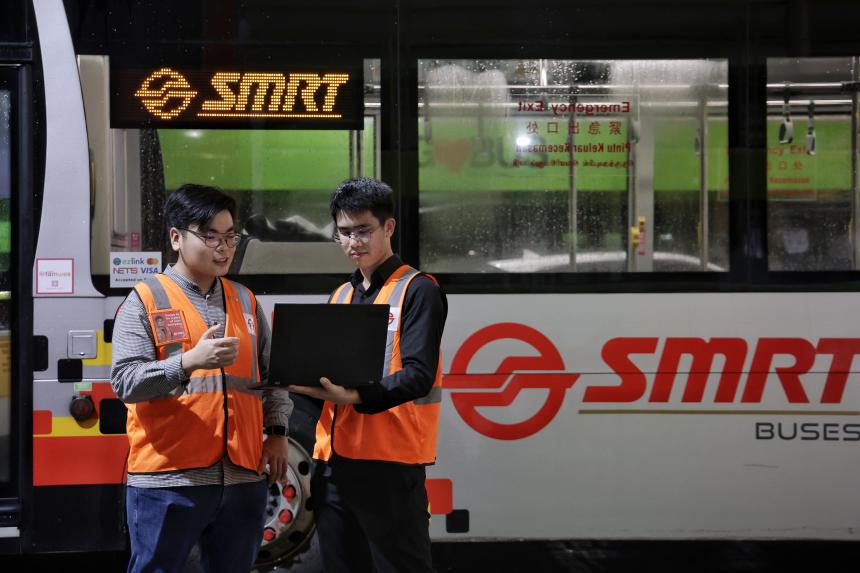SINGAPORE – Singapore Institute of Technology (SIT) students were able to improve the bus captain rostering for service 979 through a collaboration between the institution and public transport company SMRT.
Work that usually takes half a day can now be accomplished with a few clicks of a computer mouse using an automated system designed by SIT students.
For his final-year project in January 2023, Mr Clifford Chong, 25, worked with SMRT for seven months to improve how it rosters the bus drivers’ working shifts.
This manual process required SMRT staff to consider various factors, such as the bus captains’ working hours, start times and end times, to optimise productivity while ensuring safe driving conditions, including adequate rest between shifts.
Mr Chong designed an algorithm executed in the Microsoft Excel program to automate this process.
The automated user interface he designed is being used for service 979 and will be refined for deployment across more bus services.
It is one of three projects that SIT students have completed in collaboration with SMRT Buses since SIT and SMRT Corp signed a memorandum of understanding in November 2022 to strengthen their research and development collaboration for the advancement of Singapore’s transport industry.
The other two are the use of statistical analysis to optimise the maintenance of buses and the improving of a system for identifying bus captains who are at risk of getting into accidents.
A key part of the collaboration is the Transport Living Lab, which leverages SMRT’s experience as a public transport operator and SIT’s engineering capabilities to develop and implement solutions for real-world problems.
SIT president, Professor Chua Kee Chaing, told The Straits Times: “Through such initiatives like the Transport Living Lab, we are making our partners’ operational systems available as extended classrooms for our students, academic staff and industry partners to co-create solutions. This increases the level of authenticity of our education through projects grounded in the real world.”
He added that the partnership has also provided SMRT with deployable products, and SIT students have the satisfaction of seeing their work adopted and even finding jobs at SMRT.
The Transport Living Lab partnership between SIT and SMRT will run for three years until 2025, with potential for extension.
To date, 48 SIT graduates have been hired by SMRT, including Mr Chong, who was hired upon graduation in September 2023. He currently works as a system integration and support executive at SMRT Buses’ Woodlands Depot.
Mr Chong said that working with SMRT on his smart bus captain rostering final-year project better prepared him for the workforce. “It gave me a glimpse of SMRT’s work environment. I had the opportunity to work and familiarise myself with SMRT staff, so it made the transition from school to work much easier and more seamless.”
Mr Lee Joonmin, 26, a senior dispatch supervisor at SMRT who mentored Mr Chong during the project, said that working with SIT students gave him new perspectives on how operations and processes at the company could be further improved.
“Some of the ideas that they proposed really challenged me to think differently. For example, given the situation of the (manual rostering), they were able to use Microsoft Excel and data tools in ways that I had not seen before to automate the bus captain roster,” said Mr Lee.
For the students, they got to “experience the real-world challenges of working in the transport industry”, he said. “And it was also an opportunity to network with professionals and experts in the field.”

SIT moves to its new campus located within the Punggol Digital District (PDD) in September, and Prof Chua says this will facilitate the vision of the new campus functioning as a living lab.
“This co-location facilitates and deepens SIT’s linkages with companies in PDD, some of which we are already collaborating with in the education of our students and others in discussions for research collaboration.”
He added that the living lab concept at the new campus will have operational systems. These include Singapore’s largest multi-energy microgrid, which SIT is developing in partnership with Singapore Power. It will test solutions that can contribute to the Republic’s energy transition.
Developed in partnership with French energy company Engie, SIT’s district cooling system in the new campus will be used to create a test bed for the development and pilot deployment of advanced district cooling solutions.
The campus will also be equipped with 10,000 sensors for measuring ambient temperature, light and human presence. Students and partners can use the data to develop and implement solutions to enhance the campus experience and workspace efficiency.
These operational systems will create opportunities for authentic learning experiences, Prof Chua said.


